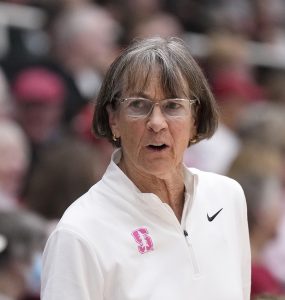Even in March Madness, the playing field remains uneven for women
This article originally appeared at Baptist News Global on April 4, 2024.
Every March, millions of people locate their yellow highlighters and black pens as they compete against family, friends and coworkers for bragging rights in their March Madness bracket contest.
It all started in a Staten Island bar in 1977, where an 88-person bracket contest required $10 bets. And it’s grown beyond everyone’s wildest imagination since then.
According to one online betting source, “2024 could be the first year that 100 million brackets are submitted across the U.S.”
But despite the rise in popularity for college basketball during March Madness every year, this year’s tournament is a glaring example of the sexism many women in the United States face because they have to deal with foolishness men don’t have to.
Inaccurate three-point lines
After five games for the women’s tournament were played on a court in Portland, Ore., the NCAA admitted the three-point lines were off. One of the lines was a whole 9 inches shorter than the other one.
“I hate to say this, but I have a lot of colleagues who would say, ‘Only in women’s basketball,” said Texas head coach Vic Schaefer. “It’s a shame, really, that it even happened.”
The NCAA wrote in a statement regarding the courts that were built by Connor Sports: “The NCAA was notified today that the three-point lines on the court at Moda Center in Portland are not the same distance. The court will be corrected before tomorrow’s game in Portland. The NCAA regrets the error was not discovered sooner.”

Head coach Tara VanDerveer of the Stanford Cardinal looks on against the UCLA Bruins during the third quarter of an NCAA basketball game at Stanford Maples Pavilion on February 4, 2024, in Palo Alto, California. (Photo by Thearon W. Henderson/Getty Images)
Even though the discrepancy was experienced by both teams for each game since teams switch sides of the court at halftime, the timing and flow of each game was affected. In the five games that were played, teams shooting at the shallow three-point line made 26% of their three-pointers, while the teams shooting at the standard three-point line made 33% of their three-pointers.
During one Sweet 16 game, Stanford was in front of N.C. State by 10 points at halftime. But during the second half, when Stanford switched to the shallow end, they were just two for 13 shooting from behind the arc, while N.C. State shot 50% at the standard end and came from behind to win the game.
In an email after the game, Stanford Coach Tara VanDerveer wrote: “Who knows how much it could impact a team? You miss shots, people get frustrated, etc. Either way, it is shoddy workmanship and a lack of accountability. When you go to the gym you trust that the lines are correct and the basket is at the right height. Not a good look.”
Misogyny in the press
Another example of sexism in women’s college basketball came from Los Angeles Times columnist Ben Bolch. In a piece published March 29, Bolch framed the matchup between UCLA and LSU as a contest between “America’s sweethearts vs. its basketball villains.”
He referred to the LSU players as “dirty debutantes” and “villains,” while calling UCLA’s women “milk and cookies.”

Ben Bolch
“Take your phone out right now and Google ‘dirty debutantes’ and tell me what it says,” LSU Head Coach Kim Mulkey retorted. “‘Dirty debutantes’? Are you kidding me?”
According to Google, “Dirty Debutantes” is one of the longest-running series in porn.
The Times republished the story on April 1 with the note: “A previous version of this commentary did not meet Timeseditorial standards. It has been updated.”
Bolch also apologized. “Words matter,” he said. “As a journalist, no one should know this more than me. Yet I have failed miserably in my choice of words. … I tried to be clever in my phrasing about one team’s attitude, using alliteration while not understanding the deeply offensive connotation or associations. I also used metaphors that were not appropriate.”





Leave a Reply
Want to join the discussion?Feel free to contribute!